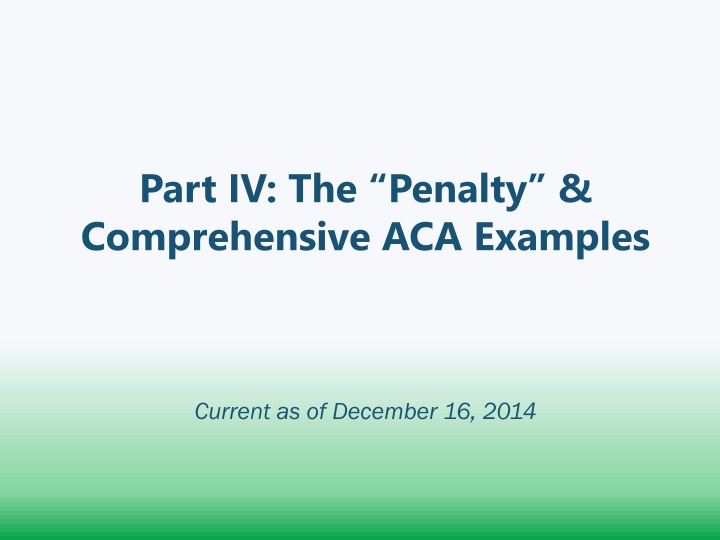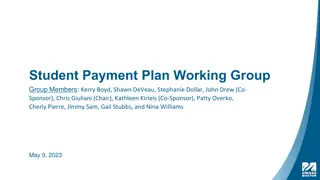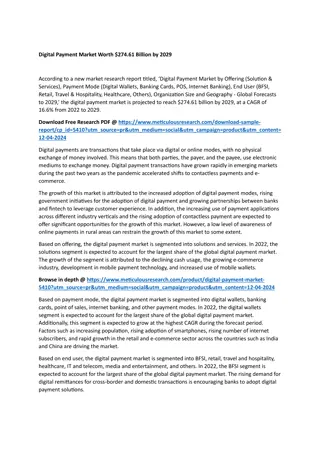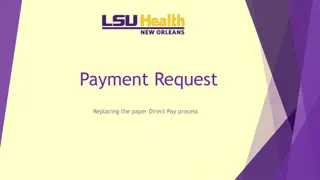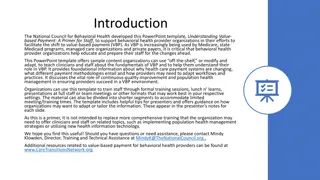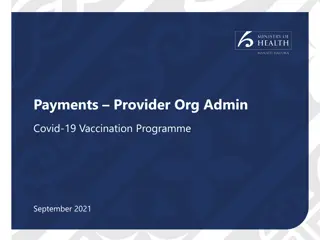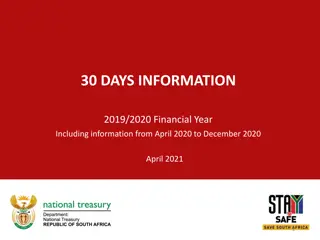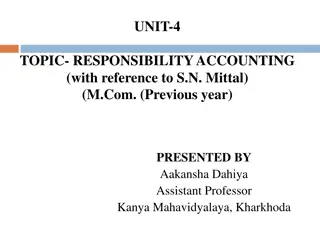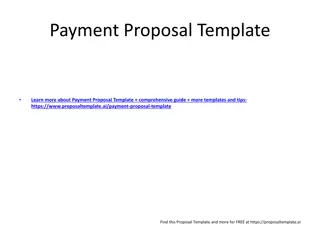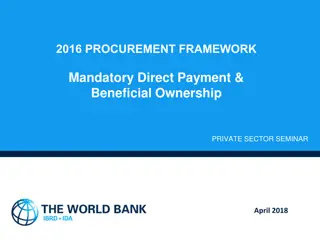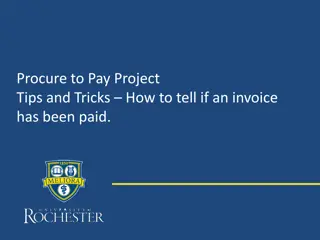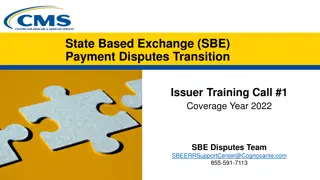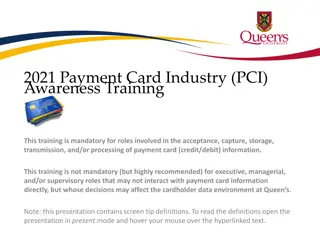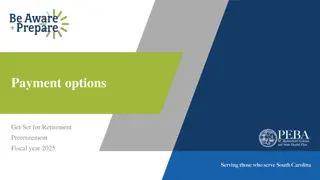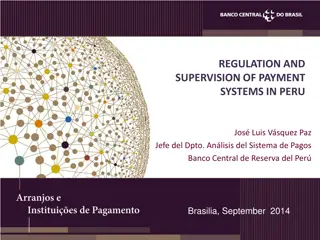Individual Shared Responsibility Payment
This content explains the Individual Shared Responsibility Payment (ISRP) under the Affordable Care Act (ACA) as of December 16, 2014. It covers the penalty for not having health insurance, steps in the tax return related to ACA, calculation methods for ISRP, and terminology used.
Download Presentation

Please find below an Image/Link to download the presentation.
The content on the website is provided AS IS for your information and personal use only. It may not be sold, licensed, or shared on other websites without obtaining consent from the author.If you encounter any issues during the download, it is possible that the publisher has removed the file from their server.
You are allowed to download the files provided on this website for personal or commercial use, subject to the condition that they are used lawfully. All files are the property of their respective owners.
The content on the website is provided AS IS for your information and personal use only. It may not be sold, licensed, or shared on other websites without obtaining consent from the author.
E N D
Presentation Transcript
Part IV: The Penalty & Comprehensive ACA Examples Current as of December 16, 2014
Reminder: Steps in the Tax Return Related to the ACA There is a requirement to have health insurance coverage starting Jan. 1, 2014. People without coverage may pay a shared responsibility payment. Did everyone on the tax return have coverage all year? YES Step 1 NO Go to Step 2. Is anyone on the tax return eligible for an exemption from the coverage requirement for any month during the year? Complete Form 8965. Step 2 If no coverage and no exemption, calculate Individual Shared Responsibility Payment using TaxWise Worksheet 8. Step 3 If someone on the tax return purchased coverage in the Marketplace and qualifies for a premium tax credit, complete Form 8962. Step 4
Individual Shared Responsibility Payment (ISRP) aka Individual Shared Responsibility Payment aka Penalty
Terminology Most people refer to this as the penalty for not having insurance. The IRS calls it the Individual Shared Responsibility Payment Individual Individual because this payment is for individuals without coverage Shared responsibility Shared responsibility because individuals, like employers and the government, have a responsibility to participate in the health insurance market. Payment Payment because it decreases the amount of tax refund or increases the balance due. We ll call this ISRP for short.
Individual Shared Responsibility Payment (ISRP) An ISRP is computed when anyone on the tax return (or who could be claimed as a dependent) did not have insurance for any month of the tax year and did not qualify for an exemption for that month. The ISRP is reported on Form 1040, line 61. In TaxWise, the ISRP is computed on Form 1040, Worksheet 8, Shared Responsibility Payment Worksheet. - In the IRS publications, the ISRP is calculated in worksheet(s) in the Form 8965 instructions, but it s not necessary to file Form 8965 unless someone is claiming an exemption.
How is the ISRP Calculated? The ISRP is calculated in two ways. The ISRP is the higher amount of the two. Percentage of Income Percentage of Income: 1% of household income above the tax filing threshold, prorated for the number of months someone was uninsured. Flat Flat D Dollar Amount ollar Amount: $95 per adult for the year (half that amount for kids), prorated for the number of months someone was uninsured. Capped at $285 for the year. The total goes on Form 1040, line 61.
ISRP Increases in Future Years The amount of ISRP is relatively low for tax year 2014 and increases in subsequent years. Year Full-year payment is greater of: 2014 1% of household income above tax filing threshold (up to cap*) $95 per adult, $47.50 per child (up to cap of $285) 2015 2% of household income above tax filing threshold (up to cap*) $325 per adult, $162.50 per child (up to cap of $975) 2016 2.5% of household income above tax filing threshold (up to cap*) $695 per adult, $347.50 per child (up to cap of $2,085) 2017 and beyond Values increased by a cost-of-living adjustment * Capped at national average premium of a bronze level plan purchased through a Marketplace. For 2014, the cap is $2,448 per individual ($204 per month per individual), with a maximum of $12,240 for a family with five or more members ($1,020 per month for a family with five or more members).
Calculating the ISRP Partial Year Coverage The ISRP is prorated for the number of months without coverage during the tax filing year Gets a job with employer coverage Uninsured and not eligible for exemption Jan Feb Mar Apr May Jun Jul Aug Sep Oct Nov Dec ISRP = 7/12 of annual calculation
Example: John (Single) ISRP Calculation: $6,850 x 1% $68.50 1. $17,000 - $10,150 = 2. $95 x 1 adult = ISRP for 2014 $95.00 Tax Filing Threshold: $10,150 Income: $17,000 Months Uninsured: 12 Filing Status: Single Adults: 1 Children: 0
Example: Reyes Family (Married Filing Jointly) ISRP Calculation: $19,200 x 1% $192.00 1. $39,500 - $20,300 = 2. $95 x 2 adult + $47.50 x 2 children = ISRP for 2014 $285.00 Tax Filing Threshold: $20,300 Income: $39,500 Months Uninsured: 12 Filing Status: Married Filing Jointly Adults: 2 (both uninsured) Children: 2 (both uninsured)
Example: Reyes Family (Married Filing Jointly) ISRP Calculation: $19,200 x 1% $192.00 1. $39,500 - $20,300 = 2. $95 x 1 adult = ISRP for 2014 $95.00 Tax Filing Threshold: $20,300 Income: $39,500 Months Uninsured: 12 Filing Status: Married Filing Jointly 2 (one insured) Adults: Children: 2 (both insured)
ISRP in TaxWise In TaxWise, the draft ISRP worksheet 8 looks like this: Warning! Warning! This is based on an early draft of TaxWise and is subject to change.
ISRP in TaxWise In TaxWise, the draft ISRP worksheet 8 looks like this: Taxpayer and dependent names will autofill here. Warning! Warning! This is based on an early draft of TaxWise and is subject to change.
ISRP in TaxWise In TaxWise, the draft ISRP worksheet 8 looks like this: If the taxpayer or dependents are under age 18 at the beginning of any month, TaxWise will check the appropriate boxes in the second row. (This affects the payment calculation.) Warning! Warning! This is based on an early draft of TaxWise and is subject to change.
Worksheet 8 It can be tricky! Check to indicate that the individual qualifies for an exemption for at least one month. Also complete Form 8965. Check to indicate that the individual had MEC all year. Check to indicate that the individual had coverage in the Marketplace for at least one month. Also complete Form 8962. Tricky! Check only the months where the person had no coverage and no exemption, i.e., the penalty months.
Client Education Opportunities Many people will be surprised by the ISRP. Here s how to help: Walk through exemption eligibility. Walk through exemption eligibility. Explain the types of situations where exemptions are granted. This educates the client about the rules and shows the client that you did your best to help. Ask about their insurance status for 2015. Ask about their insurance status for 2015. If they don t have insurance, refer them to healthcare.gov or, better yet, to a local health care assister. Depending on what kind of insurance someone qualifies for, there may be rules allowing enrollment only at certain times of the year ( open enrollment ). Remind the client that penalties are low this year but increase Remind the client that penalties are low this year but increase substantially in future years. substantially in future years. Helping them think ahead about their 2015 coverage is no different than, for example, advising a client to adjust their tax withholding for 2015.
What happens if a client cant pay the ISRP? An ISRP balance due will not affect the penalty for Underpayment of Estimated Taxes. An unpaid ISRP balance due will accrue interest but not additional penalties for late payment. The IRS will collect ISRP balances due through voluntary payments and refund offsets but is prohibited from using liens or levy to collect. The IRS will work with taxpayers who are having difficulty paying a balance due.
So many exemptions! These exemptions are available directly on the tax return. Part III Exemptions for certain individuals, in certain months: Part II Exemption for the entire family, for the entire year Certain noncitizens (including people not lawfully present) and citizens living abroad Household income or gross income below the filing threshold: Health care sharing ministry Single $10,150 Federally-recognized Indian tribe or eligible for IHS Head of Household $13,050 Limited benefit Medicaid Married Filing Jointly $20,300 Incarceration Married Filing Separately $3,950 Insurance is unaffordable (>8% of household income) Qualifying Widower $16,350 Aggregate cost of insurance is unaffordable *Amounts are for non-dependents under age 65 Short coverage gap (up to 2 months) Part III Exemption for an individual, for the entire year Coverage by May 1 or in-line for coverage Non-calendar year coverage In the Medicaid coverage gap in 2014: (1) Income < 138% FPL (2) Live in a non-expansion state
Individuals in States that Did Not Expand Medicaid Code G* New! as of 11/21/14 This exemption applies to: Individuals who resided at any time during the year in a state that did not expand Medicaid, and Had household income below 138% FPL (i.e., would have been eligible for Medicaid if the state had expanded). Medicaid Expansion Status This will be an important and common exemption in the states that did not expand Medicaid! Consult the Federal Poverty Level tables in Publication 4012. Income eligibility levels increase by family size. Note: For the 2015 tax year, a person must apply for Medicaid and be denied in order to claim this exemption. As of Dec. 1, 2014 *Note: The exemption code for this new exemption is not yet finalized.
Example Rashid was uninsured for all of 2014. His wife, Miriam, had insurance all year through work. Leila was born in November, was covered by Medicaid. Their household income was $25,000 (128% FPL for a family of 3) and they live in Texas, a non- expansion state. They are all U.S. citizens. Does Rashid qualify for an exemption? Yes, Rashid s household income is below 138% FPL and he lived in a non- expansion state. Rashid qualifies for this exemption for the entire year even if he had other insurance options, such as coverage through his wife s employer or insurance in the Marketplace with PTC. Rashid will enter Code G in Part III of Form 8965. Advise Rashid that, to claim this exemption in 2015, he needs to apply for Medicaid and get a denial to prove that he isn t eligible. It won t be this easy next year!
Example 1 Sam and his twin sister, Trudy, are age 32 and single. They lived with their mother, Sumitra, all year. Sam earned $35,000 in wages, his only income, and he is correctly filing as head of household. Sam had employer-sponsored health insurance all year. His sister, Trudy, qualifies as Sam s dependent. Sam says that Trudy had a couple of small jobs and earned $1,000 - $2,000. Trudy purchased insurance through the Marketplace but stopped making the payments. Her insurance started in February and was cancelled in September. Sumitra has an ITIN (she is undocumented) and also qualifies as Sam s dependent. She is single, age 66, and had no income. Sumitra is not eligible for Medicare and is uninsured. Coverage Months Coverage Months Jan Jan Feb Feb Mar Mar April April May May June June July July Aug Aug Sept Sept Oct Oct Nov Nov Dec Dec Sam Sam Marketplace Coverage Complete Form 8962! Marketplace Coverage Complete Form 8962! Trudy Trudy Sumitra Sumitra Do any exemptions apply? Do any exemptions apply?
Example 1 Sam and his twin sister, Trudy, are age 32 and single. They lived with their mother, Sumitra, all year. Sam earned $35,000 in wages, his only income, and he is correctly filing as head of household. Sam had employer-sponsored health insurance all year. His sister, Trudy, qualifies as Sam s dependent. Sam says that Trudy had a couple of small jobs and earned $1,000 - $2,000. Trudy purchased insurance through the Marketplace but stopped making the payments. Her insurance started in February and was cancelled in September. Sumitra has an ITIN (she is undocumented) and also qualifies as Sam s dependent. She is single, age 66, and had no income. Sumitra is not eligible for Medicare and is uninsured. Start: Does the household have income under the filing threshold? Sam s filing threshold - $13,050 Line 7a Household income (including income of dependents with a filing requirement) Line 7b Gross income (not including income of dependents with a filing requirement) Neither of these apply. Let s consider exemptions for individuals .
Example 1 Sam and his twin sister, Trudy, are age 32 and single. They lived with their mother, Sumitra, all year. Sam earned $35,000 in wages, his only income, and he is correctly filing as head of household. Sam had employer-sponsored health insurance all year. His sister, Trudy, qualifies as Sam s dependent. Sam says that Trudy had a couple of small jobs and earned $1,000 - $2,000. Trudy purchased insurance through the Marketplace but stopped making the payments. Her insurance started in February and was cancelled in September. Sumitra has an ITIN (she is undocumented) and also qualifies as Sam s dependent. She is Sumitra has an ITIN (she is undocumented) and also qualifies as Sam s dependent. She is single, age 66, and had no income. Sumitra is not eligible for Medicare and is uninsured. single, age 66, and had no income. Sumitra is not eligible for Medicare and is uninsured. Does Sumitra qualify for an exemption for her uninsured months (Jan Dec)? Based on these facts, Sumitra appears to qualify for the exemption for non- citizens (Code C). This exemption can be claimed for every month of the year because her status was the same in every month.
Example 1 Sam and his twin sister, Trudy, are age 32 and single. They lived with their mother, Sumitra, all year. Sam earned $35,000 in wages, his only income, and he is correctly filing as head of household. Sam had employer-sponsored health insurance all year. His sister, Trudy, qualifies as Sam s dependent. Sam says that Trudy had a couple of small jobs and earned $1,000 - $2,000. Trudy purchased insurance through the Marketplace but stopped making the payments. Her insurance started in February and was cancelled in September. Sumitra has an ITIN (she is undocumented) and also qualifies as Sam s dependent. She is single, age 66, and had no income. Sumitra is not eligible for Medicare and is uninsured. Does Trudy qualify for an exemption for her uninsured months (Jan, Oct-Dec)? For Jan: Short coverage gap (Code B) or Gap Prior to May 1 (Code G) For Oct-Dec: No exemption appears to apply.
Example 1 Complete the rest of the tax return then go to Complete the rest of the tax return then go to Wkt Sam is insured all year. Indicate this by checking the box Full Sumitra has an exemption all year. Check Exm separately, complete Form 8965. Trudy has an exemption in January, had Marketplace insurance Feb-Sept, and was uninsured Oct-Dec. Check Exm Exm and Mkt Mkt and check only the months when she did not have any coverage or exemption, i.e., the penalty months. Complete Forms 8965 and 8962. Wkt 8: 8: Full. Exm, do not check any months, and,
Example 1 Year Full-year payment is greater of: 2014 1% of household income above tax filing threshold (up to cap*) $95 per adult, $47.50 per child (up to cap of $285) Sam s household income is $35,000 and his tax filing threshold is $13,050. $35,000 - $13,050 = $21,950 *1% = $220 $220 * 3/12 (months uninsured) = $55 $95 * 3/12 (months uninsured) = $24 The greater of the two calculations is $55 $55 will autofill on Line 61 of Form 1040. $55 will autofill on Line 61 of Form 1040. Note that even though Sam had insurance, he is responsible for the ISRP of any dependent on his return, even the adults!
Example 1 We re not done! Complete Form 8965, Exemptions for Sumitra and Trudy Scroll down to Part III.
Example 1 Trudys 1095-A 0 0 0 255 250 99 255 250 99 255 250 99 255 250 99 255 250 99 255 250 99 255 250 99 255 250 99 0 0 0 0 0 0 0 0 0 2,295 2,250 792
Example 1 Complete Form 8962, Premium Tax Credit Most of Part 1 will autofill. Two circumstances when someone can have income under 100% FPL and still get PTC: 1. A person enrolled in a Marketplace plan, was determined eligible for subsidies and received PTC in advance, but at the end of the year had income <100% FPL. 2. Lawfully present immigrant who is ineligible for Medicaid due to immigration status.
Example 1 Question 10 reflects that we need to do the calculation monthly since Trudy was enrolled in Marketplace coverage only 8 months of the year.
Example 1 Complete the monthly calculation based on information from the 1095-A. Copy from Form 1095-A
Example 1 Complete the monthly calculation based on information from the 1095-A. Calculated by TaxWise
Example 1 Complete the monthly calculation based on information from the 1095-A. Moves to Moves to Line 46 Line 46
Example 1 Summary Sam s personal situation was simple, but he had to do quite a bit of work to account for his dependents. Because Sumitra and Trudy were properly claimed as dependents, Sam was responsible for: Sumitra and Trudy s exemptions, reported on Form 8965 The reconciliation of Trudy s premium tax credit on Form 8962 The payment of Trudy s ISRP, calculated on Worksheet 8
Example 2 Monica is divorced and works part-time. She is not offered benefits at work and was uninsured at the beginning of 2014. Her mom convinced her to sign up for coverage from the Marketplace. She completed her application on March 16, and her coverage was effective on May 1. On Sept 10, she moved to a full-time position with her employer and was eligible for health insurance. She lives in a state that did not expand Medicaid. Coverage Months Jan Feb Mar April May June July Aug Sept ? Oct Nov Dec Uninsured Marketplace coverage Employer coverage Monica A person is eligible for PTC in a month when: A person is eligible for PTC in a month when: (1) on the first day of the month, the person was enrolled in a Marketplace plan, (2) the taxpayer paid her premiums for that month by date taxes due; and (3) the individual is not eligible for other MEC for the full calendar month. So Monica gets PTC for the whole month of Sept.
Example 2 Let s deal with exemptions Let s deal with exemptions first 1. 1. Figure out whether Monica qualifies for an exemption for Jan Figure out whether Monica qualifies for an exemption for Jan- -April. Short coverage gap doesn t apply But she did secure coverage by May 1. Use Code G. first April. 2. 2. Complete Worksheet 8 Complete Worksheet 8 No uninsured/nonexempt months so check no boxes! 3. 3. Complete Form 8965 Complete Form 8965 Form 8965, Exemptions Form 8965, Exemptions
Example 2 Form 8962, Premium Tax Credit Form 8962, Premium Tax Credit Moves to Moves to Line 46 Line 46
Example 2 Summary Monica has a repayment of $130. It may be helpful to explain a few things: In the end, Monica received a $1,050 premium tax credit toward the purchase of private health insurance. The credit paid more than 2/3 of the cost of her insurance plan (total from column A). The overpayment was due to the change in her income. o In this case, the change in her income was due to her new job, which also provided her with health coverage. o When someone who will remain enrolled in Marketplace coverage has an increase in income, however, reporting the change can reduce the risk of repayment because the advance credits can be adjusted mid- year. For those who have a decrease in income, the advance credits can be increased to help them afford their monthly premiums.
